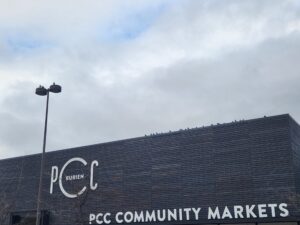Putting Technology to Work Against Nuisance Birds

CHALLENGE
The presence of birds in and around commercial properties is common. And while birds are an important part of the ecosystem, there is a downside to them nesting on ledges and signage above building entrances and loading docks or gaining access inside structures.
PCC Community Markets, a Seattle-based food co-op with 16 locations across the Puget Sound region, was dealing with nuisance bird issues at several of its locations. The birds were negatively impacting aesthetics, sanitation and the overall customer experience with their droppings and constant foraging for food.
At the Columbia City location, pigeons were present around the loading dock area eating discarded food and garbage that collected near the store’s dumpsters.
The bird issue was more intense at the Greenlake/Aurora location where birds were nesting in the signage above the store’s

Birds nesting at the PCC Community Market Burien, WA location.
main customer entrance. The birds – seagulls, pigeons, sparrows, and starlings – were attracted to the location by food waste on the exterior of the store and excess condensation from the store’s roof-mounted HVAC units.
“The birds were a nuisance in a high visibility area that also featured an outdoor seating and dining area,” said Jon Pintar, facilities manager for PCC Community Markets. “The birds would congregate on the ledge of the building and were very aggressive in their pursuit of food which was bothering customers.”
Pintar asked Sprague regional project manager Ben Estibal to assess the situation at the Green Lake store as well as two others and devise a plan to un-roost the feathered visitors.
SOLUTION
The plan had to be discreet but effective against a wide array of bird species. It also had to complement the existing pest control program for an organic facility (PCC Markets carries an extensive line of organic food products). This solution required a more thoughtful and prescribed approach.
After a thorough inspection of the Greenlake/Aurora store and confirming the bird species present, a plan was developed. It would not, however, include installing bird spikes or other traditional deterrents.
“Bird spikes would have been too visible to customers, and they would not have been effective in deterring smaller bird species,” said Estibal. “Rather than install multiple deterrents we recommended the Flock Off System.”
The Flock Off bird deterrent system disrupts internal GPS system of migratory and territorial birds, the system allows them to “see” directionally through the earth’ latitudinal and longitudinal gridline. The Flock Off unit creates an electromagnetic “force field” that, invisible to humans, makes any structure appear to birds as impossible to land upon. Any birds in the area will not land and will fly elsewhere. For more information about the system, please visit Flock Off’s website.
The installation involved placing 120 capacitors at four-foot intervals on the roof. The capacitors, which are the size of a mushroom, are connected by a single wire allowing for a seamless, low-profile installation.
“In addition to being nearly invisible to customers from ground level, the system works in areas where other deterrents could not be installed,” said Pintar, who worked closely with Estibal on budgeting for the project.
The job required close coordination with the client and training for the PCC Markets team on ongoing system maintenance practices. Sprague checks the system during regular service visits.
The installation went smoothly due in part to PCC Markets’ appreciation of the value and need for professional pest management services.
“PCC is willing to invest to protect its customers, employees, products and brand from pest threats,” said Estibal. “They are responsive and react to issues promptly. There is a lot of mutual trust between Sprague and PPC.”
RESULTS

The PCC Community Markets Greenlake/Aurora location after installing FlockOff system.
Following the installation of the Flock Off System at Greenlake/Aurora there was a noticeable reduction in the bird population and in the volume of droppings. The sign above the store’s entrance was also bird-free for the first time in a long time.
“Sprague invested the time to do a deep dive into the conditions at the store, understand the issue and look at it differently,” said Pintar. “It was not an easy fix, but they came back with a solution-driven approach that worked for us. It was a risk, but it paid off.”
Pintar said PCC management is excited about the results and is looking at additional installations in existing stores. It may also include the system in its building specifications for future locations.
Sprague’s Estibal said all bird control work is customizable based on the property’s location and species of birds present. And most bird control work is part of a client’s capital budget and needs to be planned carefully.
“We are respectful of a client’s budget when designing a program and work to identify solutions that go beyond just pest control and that deliver the best possible ROI for their investment,” said Estibal.
